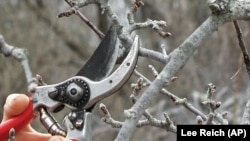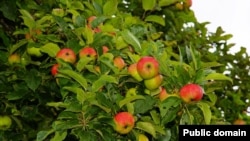If there is one group of plants that needs continuous care, it is fruit trees.
Fruit trees require a lot of pruning – the careful removal of dead, damaged or unproductive parts to make the tree grow better.
And, with the right pruning, all of the remaining branches get a good amount of sunshine.
Pruning helps fruit trees find a balance between shoot growth and fruit production. That is important for making sure the trees grow large, tasty pieces of fruit every year.
Without this balance, there may not be enough places for tree leaves to grow and fruits to hang.
The young tree
The first years are important to a fruit tree. These early years help trees develop a permanent base of branches to support a lot of fruit and get plenty of sunlight.
Centuries of fruit growing have led to many different kinds of trees, but there are three main ones: the central-leader, the open-center and the modified-central-leader.
That is a lot simpler than it sounds.
The central-leader tree has a large trunk in the center, with shorter and shorter side branches moving up the tree. It is shaped much like a Christmas tree.
The open-center tree looks almost like the opposite of a Christmas tree. It has three or four main parts growing outward and upward.
And, the modified-central-leader tree is a mix of the two: It starts as a central-leader then becomes an open-center.
These three forms let trees get enough sunlight. The ideal form for a tree depends partly on the way it grows naturally.
Get your tree in shape
Here are some ways to keep your fruit tree healthy:
Begin pruning any new tree by cutting broken stems and removing dead or diseased wood. If your new tree has just one stem, shorten it by one-third to support branch growth. If the tree already has many branches, save well-placed stems and cut away all others.
The ideal branch placement starts about six-tenths of a meter above the ground and continues up the trunk, with about 20 centimeters between branches. For open-center trees, cut off the central stem just above the third branch.
For central-leader and modified-central-leader trees, you will need to force the main stem to continue making new branches. This can be done by cutting off about one-third of last season’s growth each year.
The top bud will grow to become an upright shoot and part of the trunk or lead branch. The lower buds will become side branches. Choose new side branches that are well-spaced along the lead branch or trunk.
The mature tree
Once a fruit tree is fully developed, the act of pruning helps create a balance between shoot growth and fruit production. How to get this balance depends on where a tree grows, its flowers and how big its fruits are.
Especially with large fruits, such as apples, individual pieces of fruit are usually too small and less sweet when the tree produces a large crop. Pruning removes some possible fruits so the plant can put more energy into those that remain.
When a tree is old enough to start growing fruit, each year prune some stems and remove others completely. Shorten stems where you want regrowth and more branches. Completely remove stems where you do not want this regrowth, such as where stems are crowded.
The amount of pruning required depends on the kind of tree you are pruning. The younger the stems on which fruits grow, the more stems must be shortened.
At one extreme are peach and nectarine trees. They produce fruit only on stems that grew during the last season. So they need a lot of pruning each year to launch new shoots for the next year’s crop.
Prune enough so that a bird could fly right through the branches.
Apple and pear trees, at the other extreme, grow fruit on long-lived, very short branches called “spurs,” so they need less work. Sometimes, however, even spurs need pruning.
Most other fruit trees require more work than apple trees, and less work than peach trees. Again, completely remove some stems and shorten others to get a good balance of fruiting wood and stem growth.
I’m Alice Bryant. And I’m Susan Shand.
Lee Reich wrote this story for the Associated Press. Alice Bryant adapted it for VOA Learning English. George Grow was the editor.
_______________________________________________________________
Words in This Story
shoot – n. a new branch and its leaves on an established plant
branch – n. a part of a tree that grows out from the trunk
trunk – n. the thick main part of a tree
stem – n. the main long and thin part of a plant that supports the leaves and flowers
bud – n. a small part that grows on a plant and develops into a flower, leaf, or new branch









